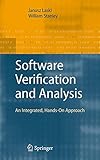Software Verification and Analysis : An Integrated, Hands-On Approach / by William Stanley, Janusz Laski.
Tipo de material: TextoEditor: London : Springer London : Imprint: Springer, 2009Descripción: recurso en líneaTipo de contenido:
TextoEditor: London : Springer London : Imprint: Springer, 2009Descripción: recurso en líneaTipo de contenido: - texto
- computadora
- recurso en línea
- 9781848822405
- QA76.758
Springer eBooks
The Semantic Analysis -- Why Not Write Correct Software the First Time? -- How to Prove a Program Correct: Programs Without Loops -- How to Prove a Program Correct: Iterative Programs -- Prepare Test for Any Implementation: Black-Box Testing -- Static Analysis -- Intermediate Program Representation -- Program Dependencies -- What Can One Tell About a Program Without Its Execution: Static Analysis -- Dynamic Analysis -- Is There a Bug in the Program? Structural Program Testing -- Dynamic Program Analysis.
This book advocates the integrated and tool supported use of all available verification methods to improve software correctness. The following major software verification techniques and their supporting tools, based on sound mathematical models, are discussed: • Correctness by construction, using the Vienna Development Method-Specification Language (VDM-SL) and its supporting CSK’s Toolbox. • Static program analysis supported by the PRAXIS’ SPARK toolset and SofTools’ System for Testing And Debugging (STAD 4.0). • Program proving supported by SPARK. • Dynamic program analysis supported by STAD. VDM-SL Toolbox and SPARK illustrate, respectively, the correctness by construction and program proving paradigms. The author demonstrates that while both methods are powerful, errors are inevitable and detecting these may be more difficult than in the case of an informally developed program. Consequently, error detection must be an integral part of the entire life cycle of a programming project. Black-Box (specification based) and Structural (code based) testing are covered and supported by STAD (including 5 testing criteria). STAD also features a quite powerful descriptive and proscriptive static analysis. Software engineers, students and computer scientists will find that the book provides the reader with a comprehensive understanding of software verification issues. STAD’s outputs allow the user to implement and test their own ideas. The most recent version of STAD can be downloaded from http://www.stadtools.com.
Para consulta fuera de la UANL se requiere clave de acceso remoto.


